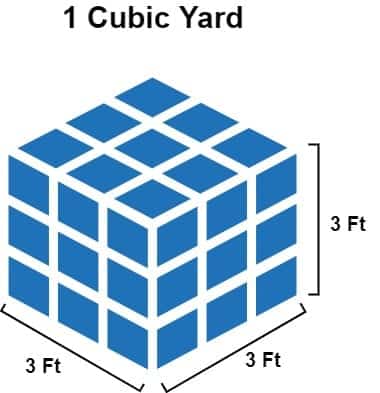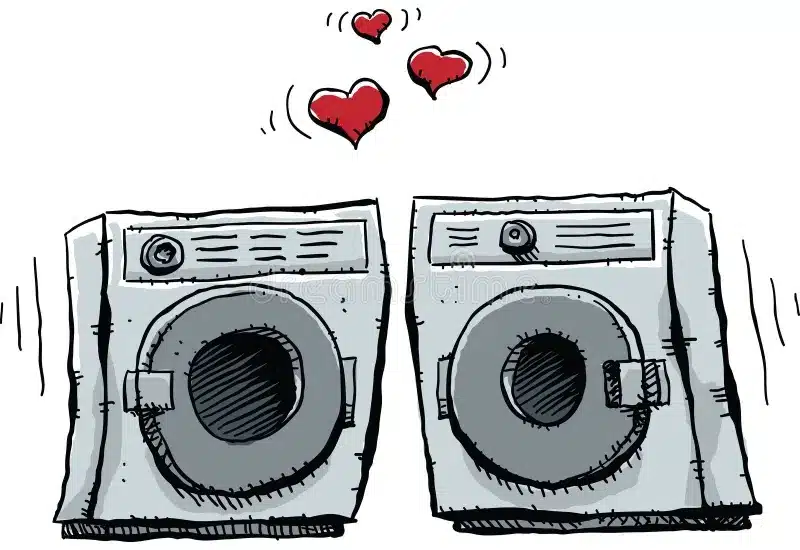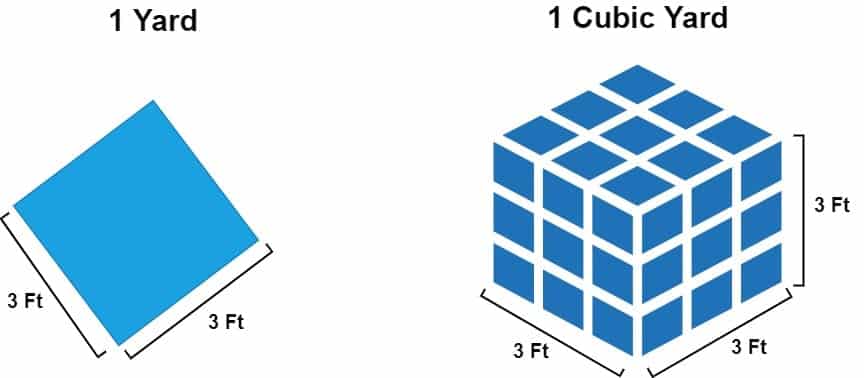Let's dive a bit deeper into the fascinating world of cubic yards! Picture a cube—yes, like the ones you may have stacked in a game or seen in a math class. Now, imagine each side of that cube measuring one yard, which is equivalent to 3 feet or 36 inches. That cube represents one cubic yard, and, interestingly, it encapsulates the concept of volume.
Breaking it down a bit more, a cubic yard is essentially the same as 27 cubic feet. Wrap your head around that for a moment—27! To put it into perspective, think about the space your washer and dryer occupy side by side. That combo typically spans just over a cubic yard.
For a visual aid, check out the illustrative picture below. It helps paint a mental picture of what we're talking about. So, the next time someone throws around the term "cubic yard," you can impress them with your mental image of a cube, the size of your washer and dryer duo, and your newfound knowledge of volume measurements!


Alright, so here's the scoop: when it comes to dumpsters, we measure their size in cubic yards, thanks to their shape. Now, don't let the fancy term scare you off—it's just a way to figure out how much stuff these bad boys can hold. Knowing how to calculate cubic yards and getting a feel for the amount of junk you want to toss can be a game-changer. It's like having dumpster superpowers!
Why does this matter, you ask? Well, if you nail down the right size, you're not just avoiding a Tetris situation with your trash; you're also dodging extra costs. See, each dumpster has a weight limit, and going over that can hit you in the wallet.
So, being the cubic yard wizard that you are will help you pick the perfect-sized container, keep within the weight limit, and, of course, save a little cash. It's like dumpster math but way more practical!

Difference Between a Yard and a Cubic Yard?
Let's clear up the yard versus cubic yard confusion. A yard is all about length and width in two dimensions, while a cubic yard steps it up with the addition of height in three dimensions. To grasp the difference, check out the visual below. It's like comparing a flat piece of paper (yard) to a pop-up book (cubic yard). Simple, right?

Volume vs. Weight
Navigating the realm of dumpster rentals involves understanding the critical distinction between two vital measurements—volume and weight. It's a game-changer, and trust me, you don't want to mix up these two when venturing into the world of waste disposal.
Now, here's a nugget of wisdom: volume and weight are not interchangeable, especially when it comes to determining the size of your dumpster. It's not as simple as throwing everything into a container based on weight alone. No sir, volume plays a crucial role here.
Let's break it down further. Knowing the volume of your waste is akin to understanding the space it occupies—how much room it takes up in that dumpster. This involves thinking in three dimensions, considering length, width, and height. On the other hand, weight is about the heaviness of the materials you're tossing.
Why does this matter? Well, my savvy waste-disposal friend, here's the secret to saving some hard-earned cash: calculate both volume and weight. By doing this, you ensure that you choose the right-sized dumpster for your needs, preventing unnecessary charges for exceeding weight limits. It's like a double-layered strategy for optimal dumpster efficiency and cost-effectiveness.
So, next time you're in dumpster rental mode, remember the dynamic duo of volume and weight. It's not just about tossing stuff into a bin; it's about understanding the space it occupies and its weightiness. That way, you'll be on your way to dumpster rental mastery, making savvy choices, and keeping your budget intact.

How Do You Calculate Cubic Yards?
To measure in cubic yards, you will need to measure out the area in inches or feet and then calculate its volume. Use these steps to determine your volume in yards:
- Measure the length, width, and height of your materials or even the area it takes up.
- Now convert those measurements to yards.
- If you measured in feet, divide the measurements by 3
- If you measured in inches, divide the measurements by 36
- Once all measurements are in yards, multiply them all together to find your cubic yard volume, or jump straight to the free calculator to find your cubic yardage.
Cubic Yard Calculator
Cubic yards are used to measure materials ranging from concrete to mulch for your garden.
Common materials that are measured in cubic yards include:
- Concrete
- Gravel
- Sand
- Rock
- Fill dirt
- Topsoil
- Mulch
- Compost
To determine the amount of materials you need in cubic yards, you must first convert all three dimensions to the same unit of measurement. There are:
- 27 cubic feet in one cubic yard (3’ x 3’ x 3’)
- 46,656 cubic inches in one cubic yard (36” x 36” x 36”)
For example, to find the amount of concrete needed for a slab 3” thick by 10’ long by 10’ wide:
- Convert the dimension in inches to feet (3” ÷ 12” = 0.25’)
- Multiply the three dimensions together to find the number of cubic feet (0.25’ x 10’ x 10 = 25 cubic feet)
- Divide the cubic feet by the number of cubic feet in a cubic yard (27) to find the number of cubic yards (25 ÷ 27 = 0.92 cu. yd.).
You can find the same result by converting all three dimensions to yards:
- Convert the dimension in inches to yards (3” ÷ 36” = 0.08333 yards)
- Convert the dimensions in feet to yards (12’ ÷ 3 = 3.3333 yards)
- Multiply the three dimensions together to find the number of cubic yards (0.08333 x 3.3333 x 3.3333 = 0.92 cu. yd.)
Or, simply input your dimensions in our handy calculator below, then click “calculate” to find the number of cubic yards.
How Big Is a Cubic Yard?
Once you've calculated the volume of your materials, it might be tricky picturing that inside a dumpster or even knowing how to choose the right disposal method. Based on the volume, you might find that renting a dumpster for a few days might be easier and safer than using a truck bed or garbage bags.
For a point of reference, here's how much each dumpster can hold based on trash bags or truckloads, the two most common ways people haul their trash.
- 10 Cubic Yard Dumpster: Equal to about 60 13-gallon trash bags or 3 pickup truck loads
- 15 Cubic Yard Dumpster: Equal to about 80 to 100-gallon trash bags or 4.5 pickup truck loads
- 20 Cubic Yard Dumpster: Equal to about 125 13-gallon trash bags or 6 pickup truck loads
- 30 Cubic Yard Dumpster: Equal to about 180 13-gallon trash bags or 9 pickup truck loads
- 40 Cubic Yard Dumpster: Equal to about 250 13-gallon trash bags or 12 pickup truck loads
The weight of your dumpster significantly influences the cost, as landfills typically charge per ton. Once we collect your container, your debris is weighed at the landfill, and the cost is determined according to their fee structure. Simplify your budgeting with our flat-rate pricing, encompassing disposal costs for a specified weight limit. As long as you stay within that limit, you’ll have a clear upfront understanding of your expenses—no need to speculate or wait until your debris reaches the landfill. Although the typical dumpster truck has the capacity to carry around 10 tons or 20,000 pounds, weight restrictions commonly range from 2 to 6 tons or 4,000 to 12,000 pounds to ensure secure transportation. We’ll inquire about the items you’re discarding to assess the weight of your debris. This enables us to recommend the appropriate bin size for your project. Additionally, you can utilize our dumpster weight calculators for a preliminary estimate. Upon arrival at the landfill, the dumpster is weighed, and the process is repeated after the debris is emptied. The variance between these two weights is then employed to calculate the weight of your debris and determine the disposal cost. A ton equals 2000 pounds. Scrap metal weighs approximately 225 pounds.

